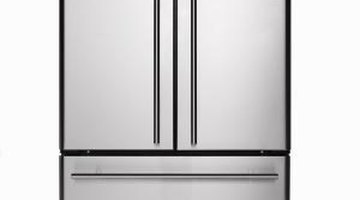The Front of My Refrigerator Is Hot
It's strange to think that an appliance designed to keep food cool would feel warm or even hot to the touch, but it's actually quite normal. Refrigerators are designed to heat up on the outside -- while still staying cool on the inside -- to reduce or eliminate condensation from forming.
Heating Pipes

Refrigerators have heating pipes built into the cabinet of the fridge. They are usually located where the gaskets -- which are the flexible seals that line the doors of your fridge -- press up against the frame of the refrigerator. In fact, this is the area where you will likely feel the most amount of warmth. The pipes are not always hot -- they cycle on and off and are controlled by a timer in most refrigerator models.
Location Matters
The location of your refrigerator might contribute to a rise in the temperature on its surface. If your fridge has a clearance of less than 1 1/2 inches between itself and the walls or cabinets, it will generate more heat. If it is located in a humid area -- such as an enclosed porch -- the front will feel hotter to the touch than if it is located in a dry, cool area.
Other Contributing Factors
Other factors might temporarily raise the surface temperature of your refrigerator, as well, making it hot to the touch. Refrigerators are hotter to the touch when they are first set up. They are warmer on hot days and during times when the doors are left open or are opened and closed much more than usual. Filling up your fridge with fresh food that is at room temperature also can make the refrigerator feel warmer to the touch, according to Maytag's customer help website. Most of these temperature increases on the exterior of your refrigerator will only last a maximum of 24 hours.
Things to Consider
Although it's normal for the exterior of your fridge to feel warm -- and even hot -- to the touch, it's not normal for it to be so hot that it feels painful. An excessively hot surface is an indication of a more serious problem. It could be that your condenser coils and fan are clogged up with dirt and debris. These are located underneath or on the lower back of your fridge. Unplug your refrigerator, vacuum the coils and fan with a hose attachment, and see if that reduces the surface temperature of your fridge. If not, it's time to call in a professional.
References
Photo Credits
- Ryan McVay/Photodisc/Getty Images
More Articles



